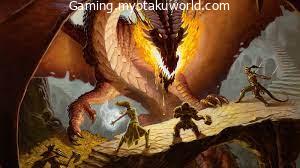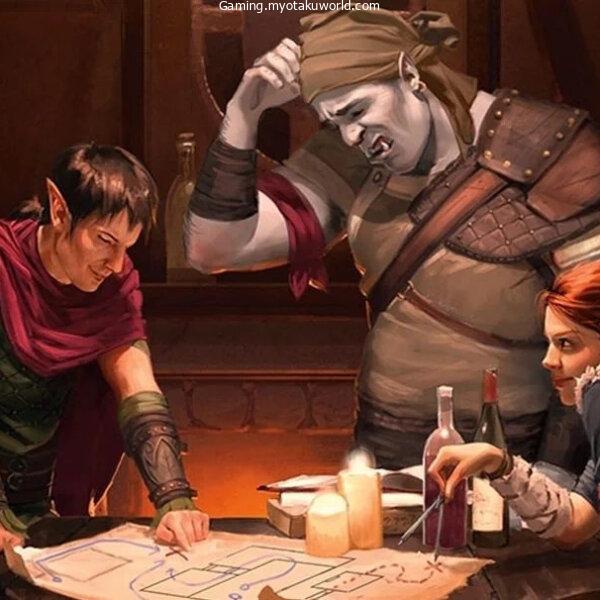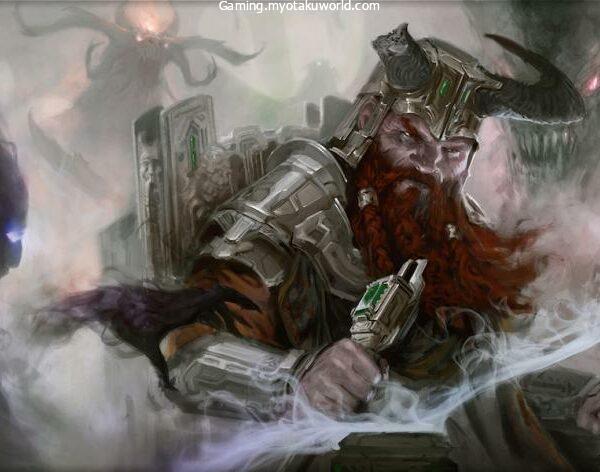Your D&D group is walking through the woods, and you see a hidden pit along the path in front of you. You enter the next room in the dungeon.
You immediately spot that the goblin’s head is sticking up from behind an erect pillar on the opposite side.
You’re in a bustling restaurant and listening to the conversations of the table that is next to you.
But you didn’t cast dice to find the trap, look for the goblin in the shadows, or listen to the conversation.
Instead, the DM simply told you what you heard or saw. Each of these situations results from your passive perception.
What is a Passive Check?
Passive checks are an ability to verify D&D that doesn’t require a roll of the die. It’s used to depict two scenarios.
The first, and most common, is to identify the extent to which a person is successful or not without actually trying. In addition, it can be used to show the typical outcome when the task is repeated.
Although there are rules for D&D that do not restrict the use of passive checks to specific abilities, the most commonly used score for passive checks is perceptual ability.
It is the only score for passives that is written on an individual character sheet.
What is Passive Perception?
Passive perception can be utilized to establish the perception average of the character. When the DC for the Wisdom (Perception) test is lower than or equivalent to the person’s perception of passive, then they are guaranteed to be successful.
The calculation of your passive perception works by multiplying it 10 times. The Wisdom (perception) modification, in this case, a first-level character will have a +3 to their Wisdom and be skilled in Perception. The perception modifier is +5. Thus, the character’s passive perception is 15.
What is the reason that Passive Perception is useful? Imagine the players are going down a hall in an underground dark dungeon. In a random area, the DM will ask you, the one in the front of the line, to roll a perception test.
You rolled a natural 1. You realize that you’ve not passed the test. What are you able to know?
In this case, your character from the game hasn’t observed anything. They aren’t aware of the fact that they haven’t noticed anything. However, you, as the persona, are aware that you missed something.
There is a danger or hidden enemy, or something in your path. This can create a tense scene where you have to either take your character out of danger or find an acceptable reason for your character to follow an alternative route. In either case, it’s messy.
If the DM would like to know the outcome of a situation without revealing that there’s an item or person to look out for, they will use their passive perception scores.
If the trap is hidden and DC 13 can see it, and the person on the first line of sight is a person with a passive sense of 13 or greater, the character will be able to notice it without a decision being made.
Thus, it is crucial to place the player with the most perceived passiveness at the top of the line and for the person to remain on watch.
If the person in front of the line was doing something like reading an article, making their blade sharper, or engaging in another activity or activity, their passive perception could be diminished through the DM without their being informed.
Hide and Seek

Perception is probably the most popular ability test. The adventurer is always aware of dangers lurking in the area, from the wilderness through the city, to the dungeon.
Enemies can lurk at every turn, and Perception is the character’s greatest chance of spotting anything before it causes harm.
If a creature from D&D tries to conceal something, they make a Dexterity (Stealth) test. Then, they roll a d20. They apply the appropriate modifier to their stealth.
If the participants are actively searching for danger and are in danger, the DM will request that the players take a Wisdom (Perception) test.
If the Perception test meets or surpasses the Stealth check the creature is detected. If the Perception score is lower it means that the creature has successfully concealed.
However, if a character has a passive sense that is greater than or equal to the stealth test, then the creature will be spotted automatically without rolling.
For instance, the hostile goblin is hidden from the group, preparing to take them out in a flurry. The DM rolls 7. The goblin gains a +6 to their Stealth and the total is 13. The party is moving towards the location where the goblin has hidden.
The cleric who is part of the party has a passive sense of 15. When the creature is in the same space that the goblin is in, they’ll instantly hear or see the goblin. The goblin won’t benefit from hiding in the area.
Surprise
Being able to perceive things at a higher level is particularly useful in getting out of ambushes and avoiding the shock of being caught off guard.
If you and your team are attacked by a band of thugs hiding in the bush, anyone whose perception isn’t sufficient to be able to see any bandits is thought to be surprised at the beginning of the battle.
A surprised person is not allowed to take part in the initial turn of battle. If the entire group is shocked, your adversaries are given a whole period of combat, altering the outcome of the whole fight.
Taking 10 and Taking 20
In earlier versions of D&D, some rules were known as “Taking 10” or “Taking 20.” The Taking 10 rule was used to indicate that the character wanted to be successful in determining a type of check and was not immediately in danger.
If you were given a few minutes to spare, you could roll the dice to improve your chances of being successful.
Additionally, if you had a long time to roll, then you can repeat the roll until you finally get the natural 20. Instead of having to go through this tedious process, the 3rd edition lets you just assume that you’ll have a roll of twenty as well as “take 20” on the die, and then automatically win.
In the end, players could either discover the most obscure room or secret and every trap or be constantly at risk, meaning that they did not have enough time to take 20 minutes for every ability test.
This can cause issues at the table as well as make managing checks challenging for dungeon masters.
In the 5th edition of D&D, the mechanic of taking 10 to 20 turns into a mechanic that is replaced with passive checks.
Since a passive check can be computed by taking 10 times any modifiers that are normally used, this mechanic is similar to that of the Taking 10 mechanic of the 3rd edition.
That means that if you’re trying to find a mysterious figure hidden in the woods, you can’t continue to roll perception tests until you’ve rolled 20. Instead, you’ll have to roll once or apply an active perception score.
Skill Floor
Your DM wants you to assess your perception. So you agree, but, no, you have rolled a one! However, your passive perception, which is what you perceive even when you’re not looking at it, is 15. How can it be that when you’re actively looking at the screen, you’re seeing less?
There are two ways DMs will use this to address this. The one is to explain that your character is suffering from temporary domestic blindness and can’t see like they normally would.
If you have a lower role than your perception, instead, you take the score of your passive. Your passive score is an ability floor.
While they might operate differently, they should produce the same outcome. If your DM has requested that you perform a perception test, this should indicate that there’s something that you should be aware of that your perception passive did not notice.
The choice of whether you go with the normal one or not, as well as your score, ought to not be a factor since they are both ineffective.
Passive Perception Modifiers

Numerous effects occur in D&D that result in changes in the ability to check, both in general and more specifically.
When you’re affected by this kind of effect, it will affect not just your wisdom (perception) checks, but the score you receive from passive checks as well.
If a creature has an advantage or disadvantage during an ability assessment or passive check, they gain an additional +5 or -5, respectively.
Certain effects only affect one sense, such as hearing or sight. In such cases, all your senses will operate in a normal way, and you will still see through these senses. However, the intention is that most perception tests can be made based on visuals.
You could technically detect if someone is hiding, but don’t be shocked by the fact that your DM has an incredible DC to check for this.
Conditions
- Blinded: You aren’t able to see, and consequently, fail a perception test that is based on sight. Your perception of sight decreases to zero. However, you can still see with other senses, but the difficulty of an assessment could be greater.
- Deafened: It is impossible to hear and will automatically fail a perception test in a hearing-related sense. The perception of hearing is reduced to zero. Perception is possible with other senses, such as vision, but the difficulty could be greater.
- Frightened: You’re at a disadvantage on ability tests. You are penalized -5 in your passive perception if the cause of your anxiety is within your sight.
- Invisible: If you’re looking for an invisibility creature, they can be seen using other senses other than sight.
- Petrified: You lose awareness of the world around you. Your perception tests fail automatically, and your sense of passive is completely nil.
- Poisoned: You are disadvantaged in ability checks. You incur a penalty of 5 points for the passive sense.
- Unconscious: You’re unaware of the world around you. Your perception checks are automatically canceled, and your perception of the world is at 0.
- Excitement: After a certain stage of exhaustion, you are disadvantaged in ability tests. You incur a penalty of 5 for your passive awareness.
The Environment
The environment around you from the light sources to the foliage and even fog can affect your sense of place.
Lightly Obscured: On perception tests that are based on sight, it is possible to be disadvantaged in an area that is lightly obscured.
You are penalized by a -5 for your passive vision. The areas that are light obscured comprise:
- Dark Light The edges that are torchlights, the twilight, or a creature able to see in the dark with Darkvision
- patches of fog
- Moderately lush foliage
Heavily Obscured: In these areas, it is impossible to see. Areas that are heavily obscured include:
- Darkness is magical and non-magical.
- Opaque fog
- thick foliage
Darkvision
The majority of D&D’s playable races in 5e feature dark vision. Many people believe this means their character is now able to see clearly in the darkness, but it’s not the case.
Instead, it lets a person be capable of seeing in total darkness, and up to a certain distance (usually sixty feet) as if they were dim light.
It means that if are in a space with a pitch-black ceiling, you are still able to see, however, you will be disadvantaged when it comes to perception tests to be able to see, and you will incur an -5 penalty on your perception passive.
If you’re in the dark region Don’t think that your awareness of the world is working for you, as the DM may have subtracted 5 and not told you.
In the reverse case, if you’re hiding and the DM states that you’ve been discovered, make sure they’ve taken into account the dim light.
Blindsight/Tremorsense/Truesight
These are the special senses some monsters possess and can be acquired by player characters by using class features or spells.
While they do not alter your perception passively they let you see without hearing or sight.
When you have this sense the effects of environmental conditions like darkness or fog don’t affect your perception.
Increasing Passive Perception
This all raises one question, how much will your passive perception get? You’ll have to look at a variety of sources to increase your Wisdom score as well as the Perception bonus.
Remember that you cannot benefit from many sources of advantages simultaneously. If you possess one or more advantages regarding perception, you’ll get a bonus of 5 points to your passive perception
Feats/Abilities
- Ability Score Increase: The best way to improve your ability to perceive is to raise your wisdom score. Attaining the maximum score of 20 provides you with an additional 5 points for your perception.
- Proficiency: The level of proficiency increases depending on your character and can reach a maximum of +6. It is possible to improve your perception by following these steps.
- You can play a half-elf, a human-like variant, a customized lineage, lizardfolk, tabaxi leonin, orc warforged, Githyanki, and the Dhampir, hexblood, or rebirth.
- You can play a custom half-orc, goliath, kenku bugbear, minotaur, satyr centaur, vedalken shifter, changeling, or verdan. Customized races exchange racial proficiency to gain an additional skill.
- Use an artificer, barbarian, bard, fighter, ranger, or rogue.
- Choose the sailor or the faction agent or the far-traveller background.
- Do the Skilled feat.-ranger, bard, barbarian, exchange changeling, bugbear, hexblood, DhampirGithyankivariant, a half-elf,
- Experience: This lets you increase your proficiency bonus by doubling for a specific ability. Thus, it can increase to 12 or more. The ability to gain knowledge in perception by following the steps of perception
- Reach the 3rd level of the bard.
- Start at the first level in Rogue.
- Perform the Skill Expert challenges. Rogue. bard.
- Observant Feat: This feat gives you a 5 percent increase in your sense of passive.
Spells
- The Owl’s Wisdom option in Enhance Ability gives you an advantage in all Wisdom checks.
Magic Items
- Candle of Invocation: Within thirty feet of a burning candle in alignment with you, you gain an advantage in all ability checks and receive an additional bonus of five points for passive perception.
- The Cloak of Elvenkind: suggests that there is a disadvantage in the perception tests for seeing you. Creatures need a -5 in their perception of passive to be able to see you.
- Eyes of the Eagle: These crystal lenses provide you with an advantage on perception tests that are based on sight. You will receive a bonus of 5 for the passive perception.
- Insight by Ioun Stone Being in tune with this item enhances your wisdom score by 2 points, up to a maximum of 20.
- Luck stone (Stone of Good Luck): The attunement gives you a +2 to any ability check.
- Robe of Eyes: The robe you wear gives you an advantage in tests of perception for seeing. You get a bonus of +5 to your passive perception.
- Rod of Alertness: By holding this rod, you gain an advantage in initiative roles and perception tests. It also grants you a 5 percent bonus on your passive perception.
- Sentinel Shield: This shield grants you an advantage on vision checks and initiative rolls. You will receive a bonus of 5 for the passive perception.
- Take of Understanding: The book will increase your wisdom score by two. It also increases your highest wisdom score by two.
- The Book of Exalted Deeds: This book can increase your wisdom score by 2 points, to a maximum of 24.
- Blackrazor: After eating a soul, this sword gives you many advantages in any ability check and grants you a bonus of 5 for passive perceptual.
Supernatural Gifts
- The Blessing of Understanding This will increase your wisdom rating by two points to the maximum.
- From the Divine Oracle, This is a gift that increases your wisdom score by two and your score of wisdom by two.
The most passive impression one could get is:
- Maximal Wisdom Score: +5
- Expertise in Perception: +12
- Observant Feat: +5
- Sentinel Shield (or similar source of benefit) +5
- Attunement to Insight Ioun Stone: +1
- Attunement to the Luck Stone: +1
- Read the Tome of Understanding: +1
- Read the Book of Exalted Deeds: +1
- Receives the Blessing of Understanding: +1
- Becomes a Divine Oracle: +1
- Total Passive Bonus: +33
Maximum Passive Perception: 43
FAQs
How do You Calculate Passive Perception?
The passive perception of your brain is 10 plus any perception modifiers. If you have an advantage in perception tests, You add +5 to your score on passive.
Do I Add my Proficiency Bonus to Passive Perception?
Yes, provided you’re proficient in perception. In the same way, if you possess the ability to perceive, this will be added to your pass score.
Can I use Passive Perception Instead of Rolling?
Yes. However, the DM should only ask you to assess your perception if you feel that your passive score isn’t adequate.
Is Passive Perception Always On?
Although you’re not disabled, your passive perception is active, but its value could change depending on the surrounding environment and other external factors. Any event that causes you to experience a negative perception results in an increase of -5 to your perception. If you’re blind or disabled, you could easily fail the tests for perception.
Final Words
Active perception came into play in 5e to simplify the process of players spotting risks and secrets without rolling each moment of gameplay.
The passive perception of your character is determined as if you have rolled the number 10 in a perception check. It acts as a base for your senses.
There are a variety of features that include environmental effects, spells, and magical items that could alter or enhance your sense of passiveness.
Perception is among the most commonly used skills within D & D 5e. It is useful to spot ambushes and discover traps.
You could also be led to treasures that are worth pursuing when you discover hidden levers and doors. It’s all in how you approach it.









